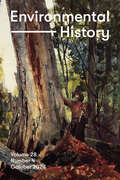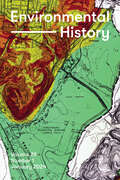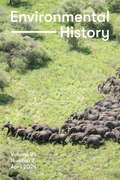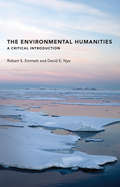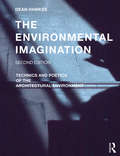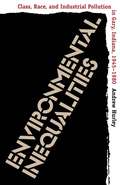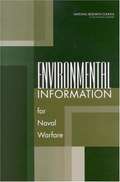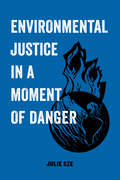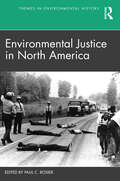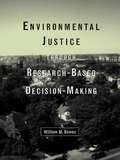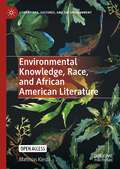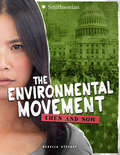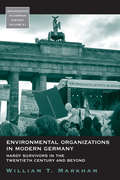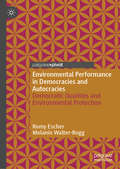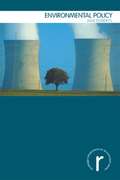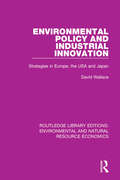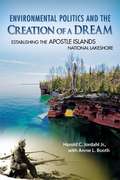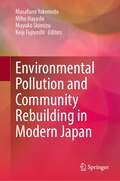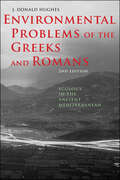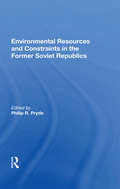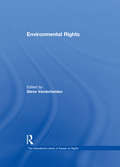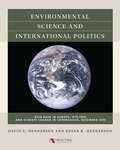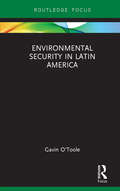- Table View
- List View
Environmental History, volume 28 number 3 (July 2023)
by Environmental HistoryThis is volume 28 issue 3 of Environmental History. Environmental History (EH) is the world’s leading scholarly journal in environmental history and the journal of record in the field. Scholarship published in EH explores the changing relationships between humans and the environment over time. This interdisciplinary journal brings together insights from geography, anthropology, the natural sciences, and many other disciplines to inform historical scholarship.
Environmental History, volume 28 number 4 (October 2023)
by Environmental HistoryThis is volume 28 issue 4 of Environmental History. Environmental History (EH) is the world’s leading scholarly journal in environmental history and the journal of record in the field. Scholarship published in EH explores the changing relationships between humans and the environment over time. This interdisciplinary journal brings together insights from geography, anthropology, the natural sciences, and many other disciplines to inform historical scholarship.
Environmental History, volume 29 number 1 (January 2024)
by Environmental HistoryThis is volume 29 issue 1 of Environmental History. Environmental History (EH) is the world’s leading scholarly journal in environmental history and the journal of record in the field. Scholarship published in EH explores the changing relationships between humans and the environment over time. This interdisciplinary journal brings together insights from geography, anthropology, the natural sciences, and many other disciplines to inform historical scholarship.
Environmental History, volume 29 number 2 (April 2024)
by Environmental HistoryThis is volume 29 issue 2 of Environmental History. Environmental History (EH) is the world’s leading scholarly journal in environmental history and the journal of record in the field. Scholarship published in EH explores the changing relationships between humans and the environment over time. This interdisciplinary journal brings together insights from geography, anthropology, the natural sciences, and many other disciplines to inform historical scholarship.
The Environmental Humanities: A Critical Introduction (The\mit Press Ser. #1)
by Robert S. Emmett David E. NyeA concise overview of this multidisciplinary field, presenting key concepts, central issues, and current research, along with concrete examples and case studies.The emergence of the environmental humanities as an academic discipline early in the twenty-first century reflects the growing conviction that environmental problems cannot be solved by science and technology alone. This book offers a concise overview of this new multidisciplinary field, presenting concepts, issues, current research, concrete examples, and case studies. Robert Emmett and David Nye show how humanists, by offering constructive knowledge as well as negative critique, can improve our understanding of such environmental problems as global warming, species extinction, and over-consumption of the earth's resources. They trace the genealogy of environmental humanities from European, Australian, and American initiatives, also showing its cross-pollination by postcolonial and feminist theories. Emmett and Nye consider a concept of place not synonymous with localism, the risks of ecotourism, and the cultivation of wild areas. They discuss the decoupling of energy use and progress, and point to OECD countries for examples of sustainable development. They explain the potential for science to do both good and harm, examine dark visions of planetary collapse, and describe more positive possibilities—alternative practices, including localization and degrowth. Finally, they examine the theoretical impact of new materialism, feminism, postcolonial criticism, animal studies, and queer ecology on the environmental humanities.
The Environmental Imagination: Technics and Poetics of the Architectural Environment
by Dean HawkesThe Environmental Imagination explores the relationship between tectonics and poetics in environmental design in architecture. Working thematically and chronologically from the eighteenth century to the present day, this book redefines the historiography of environmental design by looking beyond conventional histories to argue that the environments within buildings are a collaboration between poetic intentions and technical means. In a sequence of essays, the book traces a line through works by leading architects of the nineteenth and twentieth centuries that illustrate the impact of new technologies on the conception and realisation of environments in buildings. In this, a consideration of the qualitative dimension of environment is added to the primarily technological narratives of other accounts. In this second edition, the book has been substantially rewritten and restructured to include further research conducted in the decade since the first edition. A number of important buildings have been revisited, in order to extend the descriptions of their environments, and studies have been made of a number of newly studied, significant buildings. A completely new essay offers an environmental interpretation of Luis Barragán’s magical own house in Mexico City and the earlier studies of buildings by Peter Zumthor have been gathered into a single, extended essay that includes a body of new research. On the fiftieth anniversary of the publication of Reyner Banham’s, The Architecture of the Well-tempered Environment, the book concludes with a critical tribute to that seminal text. The Environmental Imagination will appeal to academics and practitioners with interests in the history, theory and technology of architecture.
Environmental Inequalities
by Andrew HurleyBy examining environmental change through the lens of conflicting social agendas, Andrew Hurley uncovers the historical roots of environmental inequality in contemporary urban America. Hurley's study focuses on the steel mill community of Gary, Indiana, a city that was sacrificed, like a thousand other American places, to industrial priorities in the decades following World War II. Although this period witnessed the emergence of a powerful environmental crusade and a resilient quest for equality and social justice among blue-collar workers and African Americans, such efforts often conflicted with the needs of industry. To secure their own interests, manufacturers and affluent white suburbanites exploited divisions of race and class, and the poor frequently found themselves trapped in deteriorating neighborhoods and exposed to dangerous levels of industrial pollution. In telling the story of Gary, Hurley reveals liberal capitalism's difficulties in reconciling concerns about social justice and quality of life with the imperatives of economic growth. He also shows that the power to mold the urban landscape was intertwined with the ability to govern social relations.
Environmental Information for Naval Warfare
by Committee on Environmental Information for Naval UseAccurate and timely environmental information can provide a tactical advantage to U. S. naval forces during warfare. This report analyzes the current environmental information system used by the U. S. Navy and Marine Corps and recommends ways to address uncertainty and leverage network-centric operating principles to enhance the value of environmental information.
Environmental Justice in a Moment of Danger (American Studies Now: Critical Histories of the Present #11)
by Julie Sze“Let this book immerse you in the many worlds of environmental justice.”—Naomi Klein We are living in a precarious environmental and political moment. In the United States and in the world, environmental injustices have manifested across racial and class divides in devastatingly disproportionate ways. What does this moment of danger mean for the environment and for justice? What can we learn from environmental justice struggles? Environmental Justice in a Moment of Danger examines mobilizations and movements, from protests at Standing Rock to activism in Puerto Rico in the wake of Hurricane Maria. Environmental justice movements fight, survive, love, and create in the face of violence that challenges the conditions of life itself. Exploring dispossession, deregulation, privatization, and inequality, this book is the essential primer on environmental justice, packed with cautiously hopeful stories for the future.
Environmental Justice in North America (Themes in Environmental History)
by Paul C. RosierEmphasizing the voices of activists, this book’s diverse contributors examine communities’ common experiences with environmental injustice, how they organize to address it, and the ways in which their campaigns intersect with related movements such as Black Lives Matter and Indigenous sovereignty. The global COVID-19 pandemic exposed the ways in which BIPOC (Black, Indigenous, People of Color) communities and white working-class communities have suffered disproportionately from the crisis due to sustained exposure to toxic land, air, and water, creating a new urgency for addressing underlying conditions of systemic racism and poverty in North America. In addition to exploring the historical roots of the Environmental Justice movement in the 1980s and 1990s, the volume offers coverage of recent events such as the DAPL pipeline controversy, the Flint water crisis, and the rise of climate justice. The collection incorporates the experiences of rural and urban communities, Alaska Natives, Native Hawaiians, Puerto Ricans, and Indigenous peoples in the U.S., Canada, and Mexico. The chapters offer instructors, undergraduate and graduate students, and general readers a range of accessible case studies that create opportunities for comparative and intersectional analysis across geographical and ethnic boundaries.
Environmental Justice Through Research-Based Decision-Making (Routledge Research in Public Administration and Public Policy)
by William M. BowenThis book discusses whether and to what extent there are widespread injustices and inequities caused by the distribution of environmental hazards in America today.
Environmental Knowledge, Race, and African American Literature (Literatures, Cultures, and the Environment)
by Matthias KlestilThis open access book suggests new ways of reading nineteenth-century African American literature environmentally. Combining insights from ecocriticism, African American studies, and Foucauldian theory, Matthias Klestil examines forms of environmental knowledge in African American writing ranging from antebellum slave narratives and pamphlets to Charlotte Forten’s journals, Booker T. Washington’s autobiographies, and Charles W. Chesnutt’s short fiction. The volume highlights how literary forms of environmental knowledge in the African American tradition were shaped by the histories of slavery and race, mainstream environmental writing traditions, and African American forms of expression and intertextuality. Turning to the Underground Railroad, debates over education and home-building, and the aesthetics of the pastoral and the georgic, Environmental Knowledge, Race, and African American Literature provides an original perspective on the African American ecoliterary tradition that uncovers new facets of canonical and understudied texts and offers new directions for ecocriticism and African American studies.
Environmental Law and Contrasting Ideas of Nature
by Keith H. HirokawaLaw's ideas of nature appear in different doctrinal and institutional settings, historical periods, and political dialogues. Nature underlies every behavior, contract, or form of wealth, and in this broad sense influences every instance of market transaction or governmental intervention. Recognizing that law has embedded discrete constructions of nature helps in understanding how humans value their relationship with nature. This book offers a scholarly examination of the manner in which nature is constructed through law, both in the 'hard' sense of directly regulating human activities that impact nature, and in the 'soft' manner in which law's ideas of nature influence and are influenced by behaviors, values, and priorities. Traditional accounts of the intersection between law and nature generally focus on environmental laws that protect wilderness. This book will build on the constructivist observation that when considered as a culturally contingent concept, 'nature' is a self-perpetuating and self-reinforcing social creation.
The Environmental Movement: Then and Now (America: 50 Years of Change)
by Rebecca StefoffDiscusses the main concerns of the environmental movement in the 1960s, and how those have evolved since; what's changed for the better, what might be worse, and where do we go from here.
Environmental Organizations In Modern Germany: Hardy Survivors in the Twentieth Century and Beyond (Monographs in German History #21)
by William T. MarkhamGerman environmental organizations have doggedly pursued environmental protection through difficult times: hyperinflation and war, National Socialist rule, postwar devastation, state socialism in the GDR, and confrontation with the authorities during the 1970s and 1980s. The author recounts the fascinating and sometimes dramatic story of these organizations from their origins at the end of the nineteenth century to the present, not only describing how they reacted to powerful social movements, including the homeland protection and socialist movements in the early years of the twentieth century, the Nazi movement, and the anti-nuclear and new social movements of the 1970s and 1980s, but also examining strategies for survival in periods like the current one, when environmental concerns are not at the top of the national agenda. Previous analyses of environmental organizations have almost invariably viewed them as parts of larger social structures, that is, as components of social movements, as interest groups within a political system, or as contributors to civil society. This book, by contrast, starts from the premise that through the use of theories developed specifically to analyze the behavior of organizations and NGOs we can gain additional insight into why environmental organizations behave as they do.
Environmental Performance in Democracies and Autocracies: Democratic Qualities and Environmental Protection
by Romy Escher Melanie Walter-RoggThere are considerable differences in environmental performance and outcomes across both democracies and autocracies, but there is little understanding of how levels of democracy and autocracy influence environmental performance. This book examines whether analysing the effects of individual democratic features separately can contribute to a better understanding of cross-national variance in environmental performance. The authors show that levels of social equality in particular, as well as the strength of local and regional democracy, contribute significantly to explaining cross-national variation in environmental performance. On the other hand, a high level of political corruption affects a country’s ability to adopt and implement environmental policies effectively. In exploring the inter-relationship between democratic qualities, political corruption, and environmental performance, this book presents policymakers and political theorists with a clear picture of which aspects of democratic societies are most conducive to producing a better environment.
Environmental Policy (Routledge Introductions to Environment: Environment and Society Texts)
by Jane RobertsWithin the overall context of sustainable development Environmental Policy discusses the opportunities and constraints that environmental systems place upon the operation of human systems. It suggests environmental policy is a potential way to modify the operation of human systems so that they function within environmental constraints. Key social scientific concepts (political, social and economic) are used to explain the background for the formulation and implementation of environmental policy.Environmental problems, the role of humans in creating them, sustainable development and how this concept relates to environmental policy are all introduced. The book then considers environmental policy formulation, implementation and evaluation, within three specific contexts: the firm, the nation state and at the international level. It also reviews the place of economics, science and technology in environmental policy.Detailed case-studies, drawn from a range of international examples, are used throughout to illustrate issues such as global warming, international trade, tourism and the human rights of indigenous peoples. It is well illustrated and includes end of chapter summaries and further reading.
Environmental Policy and Industrial Innovation: Strategies in Europe, the USA and Japan (Routledge Library Editions: Environmental and Natural Resource Economics)
by David WallaceThis book, originally published in 1995, examines the evolution of environmental policy in 6 OECD countries. Through numerous examples, it contrasts the widely-varying political and regulatory styles and their consequences for innovation. Two industry-specific case studies provide a transnational perspective on the co-evolution of technology and environmental policy. The book concludes that innovation can be successfully harnessed by setting credible, long-term environmental goals and ensuring that regulatory instruments are grounded in flexibility, dialogue and trust.
Environmental Politics and the Creation of a Dream
by Harold C. Jordahl Jr. Annie L. BoothThe Apostle Islands National Lakeshore is a breathtakingly beautiful archipelago of twenty-two islands in Lake Superior, just off the tip of northern Wisconsin. For years, the national park has been a favorite destination for tourists and locals alike, but the remarkable story behind its creation is little known. InEnvironmental Politics and the Creation of a Dream, Harold Jordahl, one of the primary advocates for designating the islands as a national park, discloses the full story behind the effort to preserve their natural beauty for posterity. He describes in detail the political and bureaucratic complexities of the national lakeshore campaign, augmented by his own personal recollections and those of such prominent figures as Wisconsin Senator Gaylord Nelson and President John F. Kennedy. Writing in collaboration with Annie Booth, Jordahl recounts how activists, legislators, media, local residents, and other players shaped the islands’ future establishment as a national park.
Environmental Pollution and Community Rebuilding in Modern Japan
by Masafumi Yokemoto Miho Hayashi Mayuko Shimizu Keiji FujiyoshiThis book describes how modern industry affected people in Japan and their communities by polluting their living environment with toxic emissions. It also shows how the populace endeavored not only to restore their once-clean environment but also to rebuild communities that had been damaged by pollution and its accompanying effects. Environmental pollution is usually referred to in Japan as kogai, public damage, meaning that such pollution not only harms the physical environment—air, water, soil, and the human body—but also destroys the social and personal relationships in the polluted area. Those people who took action recognized that industrial and economic development had been given the highest national priority even at the cost of their health and welfare. In this sense, anti-kogai movements led them to alternative community development and to rethinking what kind of environment and community they wanted. This book also explores the efforts driven by residents in several parts of Japan after the middle of the twentieth century and the endeavors of museums and archives as a memorial to those who suffered from the pollution and for the prospect of a better society with a good environment.
Environmental Problems of the Greeks and Romans: Ecology in the Ancient Mediterranean (Ancient Society and History)
by J. Donald HughesHow did ancient societies change the environment and how do their actions continue to affect us today?In this dramatically revised and expanded second edition of the work entitled Pan’s Travail, J. Donald Hughes examines the environmental history of the classical period and argues that the decline of ancient civilizations resulted in part from their exploitation of the natural world. Focusing on Greece and Rome, as well as areas subject to their influences, Hughes offers a detailed look at the impact of humans and their technologies on the ecology of the Mediterranean basin. Evidence of deforestation in ancient Greece, the remains of Roman aqueducts and mines, and paintings on centuries-old pottery that depict agricultural activities document ancient actions that resulted in detrimental consequences to the environment. Hughes compares the ancient world's environmental problems to other persistent social problems and discusses attitudes toward nature expressed in Greek and Latin literature. In addition to extensive revisions based on the latest research, this new edition includes photographs from Hughes's worldwide excursions, a new chapter on warfare and the environment, and an updated bibliography.
Environmental Resources And Constraints In The Former Soviet Republics
by Philip PrydeThe rapid changes in the former Soviet Union have rendered most pre-1992 works on its environment obsolete. A more specifically geographic approach that highlights the particular situation in each republic and region is offered by Philip R. Pryde’s new work, Environmental Resources and Constraints in the Former Soviet Republics. Focusing bro
Environmental Rights (The\international Library Of Essays On Rights Ser.)
by Steve VanderheidenThe essays selected for this volume present critical viewpoints from the debate about the need to establish rights on behalf of greater environmental protection. Three main areas for developing environmental rights are surveyed, including: extensionist theories that link existing rights (for example to subsistence or territory) to threats of harm from exacerbated resource scarcity, pollution or rapid environmental change; proposals for rights to specified environmental goods or services, such as rights to a safe environment and the capacity to assimilate greenhouse gas emissions; and rights that protect the interests of parties not currently recognized as having rights, including nonhuman subjects, natural objects and future generations. This volume captures the potential for and primary challenges to the development of rights as instruments for safeguarding the planet's life-support capacities and features proposals and analyses which argue the need to create an avenue of recourse against ecological degradation, whether on behalf of human or nonhuman right holders.
Environmental Science and International Politics: Acid Rain in Europe, 1979-1989, and Climate Change in Copenhagen, 2009
by David E. Henderson Susan K. HendersonEnvironmental Science and International Politics features two reacting games in one volume, immersing students in the complex process of negotiating international treaties to control environmental pollution. The issues are similar in all the modules; environmental justice, national sovereignty, and the inherent uncertainty of the costs and benefits of pollution control. Students also must understand the basic science of each problem and possible solutions. Acid Rain in Europe, 19779-1989 covers the negotiation of the Long Range Transport Pollution treaty. This was the first ever international pollution control treaty and remains at the forefront of addressing European pollution. This game can be used in a variety of ways and to examine either sulfur dioxide pollution, nitrogen oxide pollution, or both. This game includes summaries of a number of relevant technical articles to support student arguments. Students must deal with the limitations of national resources as they decide how much of their limited money to spend.Climate Change in Copenhagen, 2009 covers the negotiations at the Conference of Parties 15 meeting that was attended by a large number of national leaders. The game also includes representatives of non-government organizations and the press. Students wrestle with the need to work within conflicting limits set by their governments.
Environmental Security in Latin America
by Gavin O'TooleThis book examines security in Latin America through an environmental lens, at a time when this region faces a broad and growing spectrum of threats. The book considers the backdrop against which security debates about Latin America have been conducted; the extent to which scholarship has been dominated by traditional US strategic concerns; and how, in the changing context at the end of the Cold War, some policymakers within Latin America itself at both national and regional levels began to reposition security. It argues that traditional security scholarship focusing on military defence and strategic affairs in this region is hard to explain and out of date, and offers reasons why a new focus on environmental threats within a broader human security perspective has much to offer this field. Such a focus is justified by the scale of the challenges that environmental degradation is posing in Latin America, and the very real impact of climate change there. The book considers how the various theoretical possibilities of the term ‘environmental security’ all have some potential application to this region, where the natural environment is rapidly being securitized by military forces on behalf of their states. Finally, it proposes that a fruitful approach to Latin America might be one where human and environmental security have parity. This book will be of interest to students of environmental security, Latin American security, human geography and IR in general.

